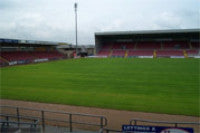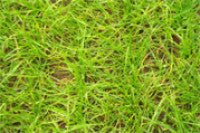Pitch reconstruction on a budget.
Pitch Reconstruction on a budget

At the end of the season we decided to remove 4" off the top of the pitch, because 2" down we had a serious black layer. We replaced with 800 tonnes of root zone, giving us about 3" of fresh surface. We then over seeded with Barenbrug Bar 7.
However, there is a major problem in the sub base. We've still got another black layer further down, but financially we were limited to about £28,000 to do the pitch reconstruction, which is peanuts in relative terms. We were forced to work to the financial limits determining how deep we could go.
We took 4" off but we did power harrow the next 4" to break it down, but we found that this next layer just broke up in great lumps. We broke it up, but really the only way to resolve our problems is a complete pitch reconstruction.
Our major problems over the past couple of years, with the heavy rainfall, has not been able to get the water through. That black
We haven't had any drainage put in this time. There is an existing system, that is less than ten years old. We felt a lot of the problem was caused by the black layer, the rainwater was filtering down and back filling on this impermeable layer and coming back to the surface. By taking off the top black layer and breaking up the one below, we're hopeful now that the water will go through to reach the drains.
The site is a former Victorian landfill site, and the pitch has been constantly on the move since its construction in 1994. We had a lot of undulations around the 18 yard area which were getting worse and worse, in some places there was deviances of 150mm over five meter stretches. We have been monitoring the levels since 1995. The council surveyors have conducted laser surveys each year to ascertain the movement and changes in levels. In recent years these level changes have slowed and we felt that we could now do some major construction with out fear of any major future movement. So at least this reconstruction will have sorted out those problems.

We've got a few soft patches and a few ruts which we needed to address as soon as possible. The patches are tractor wheel impressions and it always seems to grow greener in the dips than it does in the mountains, so it looks unsightly at the moment. However, once we get into a regular feeding regime, we'll soon get a uniform colour. This year we have been literally plagued with disease. We've got leaf spot at the moment which has just been treated with Daconil; It has been fed as well with 8:0:6 to try to strengthen it up a bit.
The pitch should be maturing nicely and more capable of withstanding disease in a couple of weeks.
It's the first time in 3 seasons we've had such a hard dose of leaf spot. We've suffered from red thread in the past, but that only highlights the need to feed and it never causes me a major problem.

The germination rate has been better than expected. The contractors put down about 12/13 x 25kg bags of seed, and we've kept some back for over seeding. The construction was a long winded job but we're now nearly 5 weeks since it was seeded. Overall it's come on really well.
We've actually had a terrible summer for growth. People keep saying we've had just the right conditions - bit of sun, bit of water, and everything else. But we've actually had a few weeks without water, and ours is a sand based pitch which dries very quickly, so I've had the irrigation working overtime.
My biggest feeling is that generally it's been cold, and the wind whistles through our open stadium. There are certain areas where the soil doesn't seem to warm up which has caused me problems with germination.
The weather reports have gone out the window - the supposedly best day of the week turns out to be the wettest one of the week. When you're fighting against that sort of thing it's very difficult to plan ahead.
Root growth in certain areas is about 3" now; in the shallow areas it's still struggling a little bit, but hopefully by the time we've got the vertidrain on, punched some holes in to get the root system going down, we can get some anchorage and penetrate a little bit more. Vertidraining will be done next week after another feed.
We will put a block on when the players can use the pitch for training. Obviously we have our first team fixtures and reserve team matches, but we're not obliged to take anything else. This year we will have to stem the training depending on how the pitch responds to use. All parties involved with the stadium pitch are pleased that the work has been carried out, and I am sure that they will respect the amount of usage possible in the early days.
The other thing that will be looked at for this season is the quantity of cup finals we host at the end of each season. This year there have been 42 local matches. I don't feel we can put that amount of games on a newly constructed pitch. But decisions will be made later in the season dependent on the wear and tear that this new surface suffers.
It is after all a community stadium, so it has to be used. In the end I think that will overrule anything we've got to say regarding the pitch side of it.


